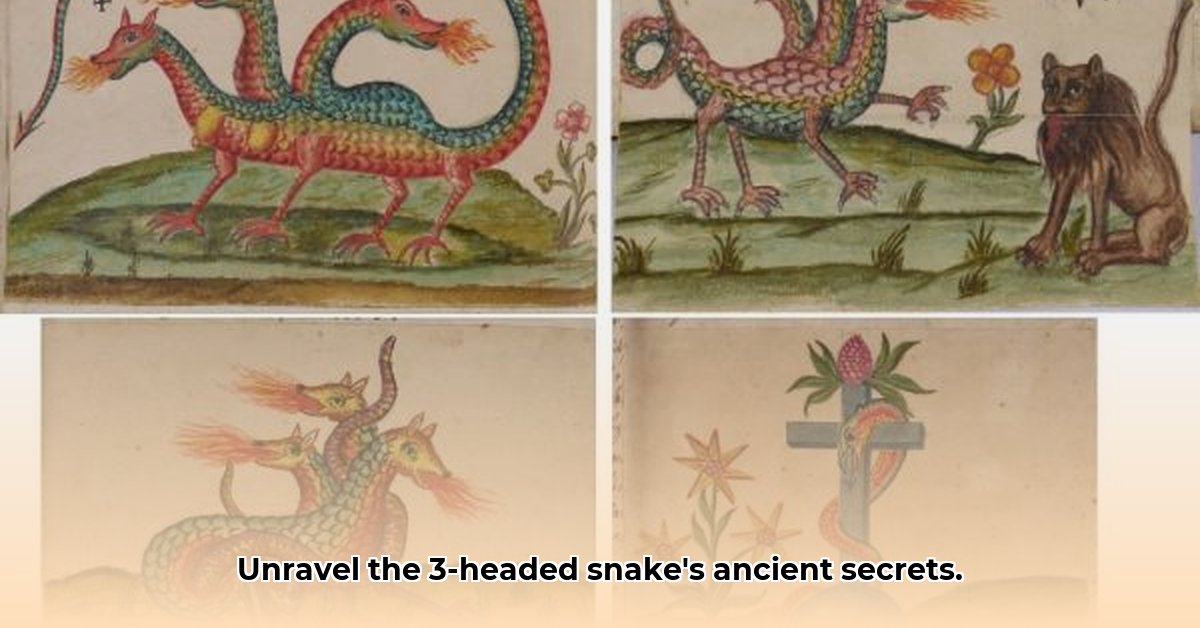
3 Headed Snake Meaning: Unraveling the Mystery
The three-headed snake, a captivating and often unsettling image, appears in myths and legends across the globe. Far from being a mere monstrous creation, this symbol carries profound layers of meaning, reflecting humanity's enduring fascination with time, the cosmos, and the complexities of the human psyche. The multiple heads themselves are key—they often hint at a deeper, multifaceted truth. But what exactly is that truth?
Isn't it remarkable how a single image can hold such varied significance across different cultures and time periods? This seemingly simple symbol has been imbued with meanings ranging from divine power to the cyclical nature of time, shaping narratives and religious practices for millennia.
Time Traveler: Past, Present, Future
Many ancient cultures viewed the three heads as representing the past, present, and future – a potent visual metaphor for the ceaseless flow of time. The snake's ability to shed its skin and be reborn perfectly embodies this cyclical concept, offering a visual reminder of time's relentless march and the transient nature of all things. But this is only one interpretation, among many.
A Cosmic Trinity?
The three-headed snake could also represent a divine trinity, echoing the structure found in numerous religions worldwide. The Hindu Trimurti (Brahma, Vishnu, and Shiva) and the Christian Holy Trinity are just two examples of three-part deities, mirroring the three heads of the serpent and suggesting a powerful connection between creative, preservative, and destructive forces in the universe. This interpretation speaks to the fundamental balance between creation and destruction. A fascinating perspective, isn't it?
The Human Inside: Body, Mind, and Spirit
Perhaps more surprisingly, the three heads can also be interpreted as representing aspects of the human self: the physical body, the rational mind, and the spiritual soul. This perspective emphasizes the interconnectedness of our physical, mental, and emotional being, highlighting the importance of balance for holistic well-being. This symbol, then, becomes a reminder of our inner complexity.
Guardians of the Otherworld
In certain mythologies, the three-headed serpent functioned not as a passive symbol, but as an active guardian—protector of sacred spaces or the underworld. This role underscores the serpent's association with power, wisdom, and the mysteries surrounding life and death. Consider, for instance, the Greek underworld, often guarded by serpents, emphasizing the snake's liminal role between worlds.
Around the World: Different Meanings
It's crucial to remember that the meaning of the three-headed snake is not monolithic. The symbol's interpretation varies significantly across cultures, reflecting unique historical, religious, and mythological contexts. A three-headed serpent in ancient Greece holds a different weight than its counterpart in a Native American cosmology, emphasizing the symbol's adaptability to various sociocultural frameworks.
Healing and Transformation
Many cultures associate snakes, especially those with multiple heads, with healing and transformation. Their ability to shed skin and regenerate serves as a compelling metaphor for renewal and rebirth. In this context, the three heads might represent a comprehensive healing process, encompassing the physical, mental, and spiritual aspects of a person's journey. The imagery becomes potent in its representation of growth and change.
The Three-Headed Snake Today: Still Relevant
The enduring presence of the three-headed serpent in modern art, literature, film, and video games demonstrates its continued resonance with contemporary audiences. Contemporary artists often reinterpret the image through fresh lenses, reflecting modern perspectives and concerns. This longevity speaks to the symbol's remarkable power to transcend time and culture.
How to Interpret Three-Headed Serpent Symbolism Across Cultures
Key Takeaways:
- The three-headed serpent frequently symbolizes a trinity or cyclical existence.
- Interpretations vary significantly across cultures and historical periods.
- Comparative analysis reveals both common themes and unique regional variations.
- Continued research is essential for a complete understanding of the symbol's complex meanings.
The Trinity and Cyclical Nature
The persistent appearance of the three-headed serpent across diverse cultures highlights its profound symbolic significance. The recurring motif often represents a powerful trinity, whether it's the past, present, and future; creation, preservation, and destruction; or mind, body, and spirit. Understanding this multifaceted symbolism is fundamental to deciphering its meaning.
Cultural Variations: A Global Perspective
The snake's meaning is context-dependent. In some traditions, it embodies benevolent guardianship; in others, it represents chaos. Consider the following examples:
Ancient Greece: Frequently linked with Hecate, the three-headed serpent embodies the mysteries of the underworld and life's transformative nature.
Mesoamerica: Mesoamerican cultures often depicted serpent deities with multiple heads, representing powerful natural forces associated with fertility, rain, and cosmic cycles.
Hinduism: In Hindu mythology, the serpent embodies both creation and destruction, reflecting the inherent duality of the universe. Three heads could amplify this duality.
Deciphering the Meaning: A Step-by-Step Approach
To accurately interpret the three-headed serpent in a specific context, follow these steps:
Identify the Cultural Context: pinpoint the culture and historical period.
Analyze Visual Details: examine accompanying symbols, posture, and materials.
Research Related Myths and Legends: seek out cultural narratives associated with the image.
Compare with Similar Symbols: analyze its relation to other three-headed creatures or serpentine symbols within the culture.
Consider Multiple Interpretations: acknowledge the possibility of multiple meanings.
Challenges and Ambiguities
Interpreting the three-headed serpent requires nuance and sensitivity. Meaning is often context-dependent and sometimes ambiguous. The lack of extensive written sources for some cultural depictions contributes to interpretive uncertainties. Recognizing these ambiguities is essential for a thorough and responsible analysis.